Mastering Whole Chicken Cooking Techniques
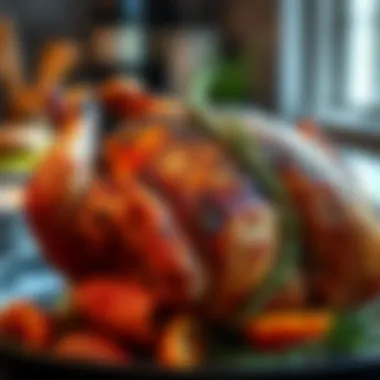
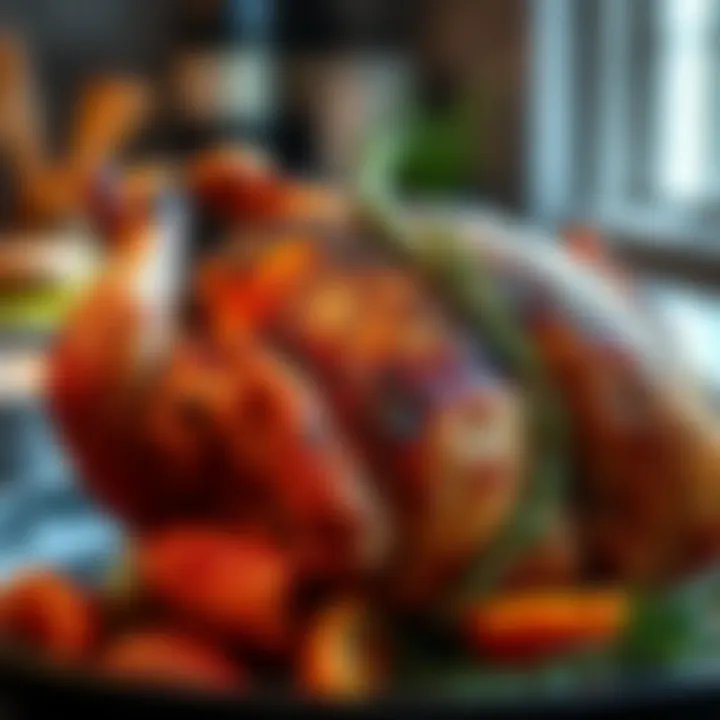
Intro
Cooking a whole chicken can be a transformative experience, turning an ordinary meal into something remarkable. Whether it’s a midweek dinner or a gathering with family and friends, mastering this skill can elevate your culinary prowess to new heights. It's not just about throwing a bird in the oven and hoping for the best; it’s about understanding the nuances that lead to a flavorful, juicy feast.
In this guide, we will dive deep into the various techniques and considerations vital to achieving optimal flavor and texture when cooking whole chicken. We will explore everything from selecting your chicken to seasoning it perfectly, discovering the right cooking methods that suit your style, and finally, how to serve it in a way that impresses. By the time you’re done reading, you will not only know how to cook a whole chicken, but you will also appreciate the art behind it.
Cooking isn’t merely a task; rather, it is a delightful journey that encompasses creativity, precision, and the joy of sharing good food with others. So, let’s roll up our sleeves and embark on this culinary adventure.
"A great meal begins long before you step into the kitchen." - Unknown
Understanding the basics, sharpening your knife skills, and knowing where to find the freshest ingredients are all part of the experience. Each element plays a crucial role in the overall success of your dish, ensuring that not only do you satisfy your palate, but you also create memorable moments for those you cook for.
Prelims to Cooking Whole Chicken
Cooking a whole chicken can seem like a daunting task, but it’s a skill that pays off in delicious rewards. Whole chickens provide an opportunity to experiment with flavors and techniques, making them a staple for both novice cooks and seasoned chefs alike.
This article aims to shine a light on the art of cooking chicken whole, offering not just a series of steps, but a deeper understanding of why preparation matters. Cooking chicken properly isn't just about avoiding foodborne illness; it’s about achieving the perfect blend of juiciness and flavor that can only come from a well-handled bird.
Importance of Cooking Chicken Properly
Well, proper cooking of chicken brings safety and satisfaction. Under-cooked chicken can lead to serious health risks, particularly from bacteria like Salmonella and Campylobacter. However, going beyond safety, here’s why it truly matters:
- Flavor Exploitation: When cooked adequately, chicken breast becomes tender, and every bite bursts with flavor. A well-roasted chicken offers the type of flavor that elevates any dining experience.
- Textures that Delight: The contrast between crispy skin and juicy meat can only be achieved with the right cooking methods and timing.
Proper cooking isn’t just a guideline; it’s a gateway to culinary mastery.
Choosing the Right Chicken
When it comes to selecting a chicken, the choices can be overwhelming. Terms like organic, conventional, free-range, and cage-raised bombard the grocery aisle. Each option brings its own flavor, texture, and ethical considerations to the table.
Organic vs. Conventional
Choosing between organic and conventional chicken often boils down to philosophy and pocketbook. Organic chicken is raised without synthetic pesticides or antibiotics, which can make it a healthier option. Its meat, as a general rule, tends to carry a richer taste, attributed to the chickens being fed organic grains and being raised in better living conditions. However, conventional chickens are often more cost-effective and still suitable for a delicious meal. Just bear in mind, conventional methods may involve the use of hormones and antibiotics, raising questions about long-term health impacts. It’s like choosing between your favorite diner and a high-end restaurant; both can fill you up but might come with different side effects.
Free-Range vs. Cage-Raised
The distinction between free-range and cage-raised poultry underscores a lot about animal welfare and flavor. Free-range chickens are allowed some space to roam and feed naturally, which, in turn, contributes to their flavor. These birds typically have more visible muscle development and healthier fat distribution, enhancing the taste of the meat. On the flip side, cage-raised chickens are kept in confined spaces, which can affect their stress levels during growth. Stress affects meat quality and taste, leading to a product that's less desirable. While cage-raised options may be budget-friendly, free-range options often win hands down in terms of taste and ethical considerations. A good piece of chicken is not just about the meat; it’s about the life it lived.
Preparation Phase
The preparation phase is an essential aspect of mastering whole chicken cooking. It lays the groundwork for flavors to come and dictates the overall outcome of your dish. Without the right preparation, even the finest ingredients can fall flat, much like a pancake not flipped at the right moment. The focus here is on the tools you'll need, how to defrost the chicken safely, and the importance of cleaning and trimming before cooking.
Essential Tools Needed
Knife and Cutting Board
A good knife and a sturdy cutting board are your first allies in the kitchen. Having the right knife—sharp and well-maintained—makes all the difference. A chef's knife is often seen as the workhorse for these tasks. It allows for precise cuts whether you're quartering the chicken or dealing with larger cuts. The cutting board needs to be durable; wooden boards are often gentle on your knives while also being easy on the eyes in a rustic kitchen. They also tend to harbor fewer bacteria than plastic boards, making them a popular choice for the home cook. However, be wary of not soaking them, as that can warp the wood.
Meat Thermometer
The meat thermometer is arguably your most critical tool when cooking chicken. Undercooked poultry poses health risks, whereas overcooked chicken can turn into an unappetizing dry mess. A digital instant-read thermometer is often favored due to its quick response time. With it, you can accurately check doneness in the breast and thigh. That ranges from around 165°F for safe consumption. The downside, however, is if you rely solely on visual cues, you might end up with a dish that’s more luck than skill.
Roasting Pan
A good roasting pan should not only hold the chicken but also provide enough space for vegetables or herbs for flavor enhancement. Many cooks opt for a heavy-duty stainless steel option that can withstand high temperatures while ensuring even heat distribution. A vestige of its past is its versatility; it can also serve in baking or even for roasting other meats. However, make sure to choose a pan that fits in your oven without squeezing too much—nobody likes the sound of a pan wrestling with its confines.
Defrosting Techniques
Refrigerator Method
Defrosting in the refrigerator is the gold standard, although it requires some foresight. The key characteristic of this method is its safety; it allows for a slow and even thaw, reducing the chances of bacterial growth. Depending on the chicken size, it might take a full day or more, which means you must plan ahead. The biggest advantage is that the chicken stays at a safe temperature throughout, ensuring meat quality. However, if you're tight on time, this method is not the way to go.
Cold Water Method


For those on a tighter schedule, the cold water method can be a lifesaver. You submerge the chicken in cold water, changing it every 30 minutes to keep it safe. The unique feature of this approach is speed; it can thaw a whole chicken in a couple of hours instead of the full day. However, it does require some diligence, as you need to be mindful about changing the water and ensuring it remains cold—otherwise, you're just inviting trouble.
Cleaning and Trimming
Removing Gizzards
When it comes to cleaning your chicken, removing the gizzards is an often overlooked but critical step. These parts can be used to create a flavorful stock if you desire, but if that's not in your plans, it’s best to toss them. A sharp knife helps here, allowing for a clean cut without tearing the meat. Not doing this step can lead to an unexpected texture as you bite into the cooked chicken. So, ditch the gizzards to keep your dish elegant and refined.
Washing the Bird
The debate about washing chicken is ongoing, but many chefs avoid it due to the risk of cross-contamination. Instead, focusing on cooking the chicken properly may be the more prudent choice. However, if you choose to wash it, keep in mind to clean your sink and equipment thoroughly afterward. The importance of this step lies in confidence; having a clean starting point can ease any anxiety about food safety. Just remember that the chicken will be cooked to safe temperatures, making washing not as significant as once thought.
Seasoning and Marination
Seasoning and marination are the unsung heroes in the journey of cooking a whole chicken. They transform a relatively simple protein into a flavorful and succulent culinary creation. To season is to enhance; it's akin to adding a sprinkle of magic that elevates your dish from mundane to extraordinary. Marination takes it a step further, allowing flavors to penetrate the meat, ensuring every bite radiates a burst of savory satisfaction.
Choosing Marinades and Rubs
Herb-Based Marinades
Herb-based marinades are a fantastic choice for anyone looking to add a fresh, vibrant taste to their chicken. They typically combine herbs like rosemary, thyme, and basil, alongside olive oil, garlic, and lemon juice. This concoction not only infuses the chicken with flavor, but it also helps to tenderize the meat. The moisture from the marinade penetrates the chicken, keeping it juicy throughout the cooking process. One of the unique features of herb-based marinades is their versatility; they can be adjusted easily based on what herbs you have on hand or what flavor profile you’re aiming for. However, one downside is that the fresh herbs can lose their potency if left marinating for too long, so timing is important.
Spice Blends
On the flip side, spice blends open up a whole new world of flavor possibilities. Ingredients like paprika, cumin, and coriander come together to create a robust profile that can range from mildly seasoned to fiery hot. The key characteristic of spice blends is their ability to deliver depth and complexity to your chicken without overpowering it. They can be customized—add a bit of cayenne if you want heat, or a pinch of brown sugar for sweetness. A significant advantage of spice blends is their shelf life; they can last for quite a while when stored properly. However, a potential disadvantage is the risk of the spices clumping together if exposed to moisture.
Marination Techniques
Time Considerations
When it comes to marinating, timing is everything. Marination time can hugely affect the texture and overall flavor of your chicken. For a quick marinade, 30 minutes can suffice for flavor infusion, especially with robust ingredients. But for deeper flavor penetration, marinating overnight can yield excellent results, allowing the flavors to really settle into the meat. The disadvantage with excessive marination, however, is that the chicken can become overly salty or mushy, especially if you're using acidic components like vinegar or citrus. Hence, finding that sweet spot is crucial.
Injection Methods
Injection methods are less common but do offer unique advantages. This technique involves using a syringe to infuse marinade directly into the meat. This can lead to unparalleled flavor distribution, reaching those inner bits that typical marinating can miss. It’s particularly useful for larger cuts like a whole chicken, where surface marinating might not suffice. The downside, however, is that this method requires some practice to prevent over-saturation and ensure even flavoring. It can also be a bit messier, as it involves extra tools and cleanup.
Key Takeaway: Proper seasoning and marination are pivotal in cooking a whole chicken, impacting both flavor and texture. Choosing the right method, whether it be herb-based marinades or injection techniques, can truly elevate your dish.
Cooking Methods
Understanding the various cooking methods is essential in mastering the art of cooking a whole chicken. Cooking methods significantly affect not only the flavor but also the texture and juiciness of the finished dish. Each technique has its pros and cons, impacting how the chicken turns out. The choice of method can alter the cooking time, the levels of moisture retention, and even color. For instance, high-temperature roasting creates a crisp skin, while slow cooking keeps the meat tender and moist.
Every cooking method offers a different experience, encouraging a culinary adventure. Whether you’re after that golden-brown skin or melt-in-your-mouth tenderness, knowing the ins and outs of each method can help steer your cooking in the right direction. Let’s dive into some of the popular methods of cooking a whole chicken, each having its own unique flair.
Roasting Whole Chicken
Roasting is perhaps one of the classic methods for cooking a whole chicken. It creates a delightful balance of crispy skin and moist, flavorful meat. This method is favored for family dinners and festive gatherings. The roasting method can be done high-temperature or low and slow, each having distinct characteristics.
High-Temperature Roasting
High-temperature roasting, at around 425 to 475 degrees Fahrenheit (218 to 246 degrees Celsius), is all about speed and efficiency. Cooking the chicken at high heat browns the skin beautifully while sealing in the juices. This method is particularly popular among those who don’t have hours to spend in the kitchen but still crave a home-cooked meal.
One key characteristic of high-temperature roasting is how it creates that sought-after crispy skin. This is achieved through the Maillard reaction, which occurs at higher temperatures, producing complex and flavorful compounds. The benefit of this technique is the rapid cooking that maintains moisture inside the bird.
However, one might need to keep an eye on the chicken, ensuring it doesn’t dry out or burn, as cooking too fast can lead to uneven doneness if not monitored closely.
Low and Slow Roasting
Alternatively, low and slow roasting takes a more patient approach. Cooking at around 325 degrees Fahrenheit (163 degrees Celsius) for several hours allows the meat to cook thoroughly, gradually breaking down connective tissues. This method is beneficial for achieving that tender, fall-off-the-bone texture that folks dream about.
A hallmark of this process is the deep flavor that develops over time. While it does require more time in front of the oven, the rewards are significant. Expect juicy results as the chicken absorbs flavors from herbs and spices used during marination.
That said, the downside of this method is the lack of crispiness on the skin unless finished off under high heat towards the end.
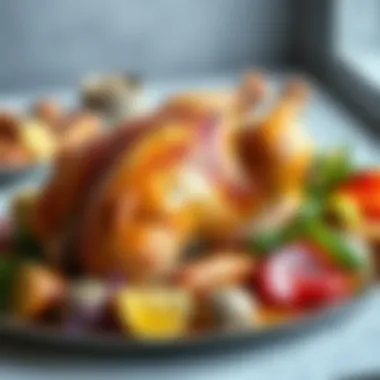
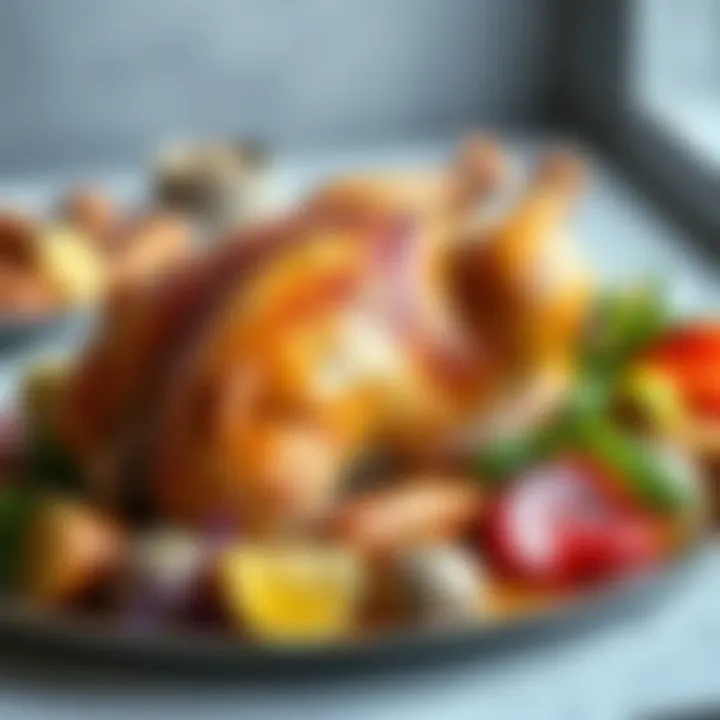
Grilling Techniques
Grilling offers a fantastic alternative to roasting, adding a smoky flavor that is unmatched. There are two main techniques: direct heat and indirect heat, each presenting its own set of advantages.
Direct Heat Cooking
Direct heat cooking on a grill involves placing the chicken directly above the flame. It cooks the exterior quickly, making it charred and crisp. This method works well for smaller pieces of chicken or spatchcocked whole chickens.
The advantages here are speed and the desirable grilled texture. The downside, however, is the risk of burnt skin or raw meat inside if not careful, requiring attention and frequent checking while cooking.
Indirect Heat Cooking
On the other hand, indirect heat cooking involves placing the chicken away from direct flames, using the grill's ambient heat. This technique allows for a slower cooking process that doesn’t overpower the meat, resulting in juicy, flavorful bites.
It's a popular choice for whole chickens, allowing for even cooking. The challenge might be maintaining consistent grill temperature, which requires a bit of practice. However, the final product often shines in flavor and juiciness, making it a worthy endeavor.
Slow Cooking Methods
Finally, let’s talk about slow cooking methods. These techniques offer a hassle-free way to prepare chicken and are perfect for those who prefer to set it and forget it.
Crockpot Cooking
Crockpot cooking allows you to infuse flavors slowly over several hours. The chicken cooks in its juices and any added ingredients. This method results in extremely tender meat that practically falls off the bone.
The key characteristic of this method is convenience—set it in the morning before work, and when you return home, a full meal awaits. It may lack that crispy skin, but it compensates with delicious flavor concentration.
However, the long cooking time can be a drawback for those who prefer quicker meals, and it requires pre-planning.
Pressure Cooking
Then there’s pressure cooking, which offers a faster alternative to traditional slow cooking. Using high pressure, it cooks food quickly while retaining moisture. The unique feature of pressure cooking lies in its ability to lock in flavors and cook the chicken in a fraction of the time.
This method not only saves time but also yields juicy, tender results—perfect for busy evenings. Yet, the texture may not always replicate that of slow roasting, while also needing a learning curve to master the cooking times.
In summary, selecting the right cooking method is crucial in achieving a delicious whole chicken. Each method has its own characteristics, offering diverse flavors and textures. The right choice ultimately depends on one’s time constraints and personal taste—so experiment and find what works for you!
Choosing your cooking method wisely can make all the difference between a good meal and a wow meal. It’s all about knowing what you want out of your chicken!
Checking Doneness
Knowing when a whole chicken is done is more than just a culinary consideration; it's crucial for ensuring food safety and enjoying a flavorful meal. Cooking chicken improperly can lead to undercooked meat, posing health risks, or overcooked chicken that results in dry, flavorless meat. In this section, we will explore the essential techniques for checking doneness, focusing on the use of a meat thermometer and recognizing visual indicators. These methods provide a reliable way to guarantee that your chicken is cooked to perfection, preserving its juiciness and flavor.
Using a Meat Thermometer
A meat thermometer is a must-have tool in every cook's kitchen. It's known for delivering accurate temperature readings, ensuring that chicken reaches a safe internal temperature without sacrificing tenderness. For whole chickens, the USDA recommends that the thickest part of the breast or thigh reaches at least 165°F (74°C). By using a thermometer, you take the guesswork out of cooking. It's also important to insert the thermometer correctly; place it deep into the thigh without touching the bone. A simple beep can make all the difference between a perfectly cooked chicken and an unfortunate kitchen mishap. The peace of mind that comes with knowing your meat is safe to eat is invaluable.
Visual Indicators of Doneness
Visual cues can also help chefs determine whether their chicken is thoroughly cooked. While a meat thermometer is the most reliable method, being able to identify certain signs can boost confidence. Observing the following two aspects can significantly aid in this process:
Juices Running Clear
The appearance of juices that run clear is a classic indicator of doneness. When you cut into the chicken, whether for serving or testing, the juices should be transparent instead of red or pink. This clear juice is a strong sign that the meat has been cooked through, as it indicates that any residual blood has cooked off. This method is simple and can be quite effective, especially for novice cooks.
The benefit of checking for clear juices is that it allows you to confirm doneness without needing a thermometer every time. However, it’s essential to understand that this method can sometimes be misleading due to factors like the cooking method or sauce being used. For instance, if your bird is marinated in a red wine sauce, the juices may appear tinged even when fully cooked. Thus, it’s best used in conjunction with other checks.
Color of the Meat
Another common method involves observing the color of the meat, particularly in the thigh area, which tends to take the longest to cook. Well-cooked chicken should have a whitish or light brown color throughout. If you notice pink areas near the joint where the leg meets the body, it's a sign that the chicken may need more time cooking.
The color inside the meat, especially around the bone, is an important marker of doneness. This is especially prominent in darker meat like thighs. Meat color can vary based on various factors, including age and diet of the bird, as well as cooking techniques used, which may lead to some variability. One advantage of using color as an indicator is that it’s visible to the naked eye. However, this method is quite subjective and may have its limitations. Relying solely on color can lead to misunderstanding among less experienced cooks, making it imperative to combine this approach with other indicators for the best results.
Resting and Serving
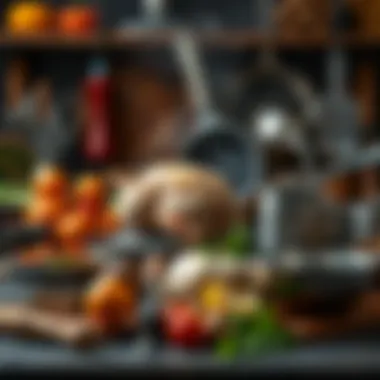
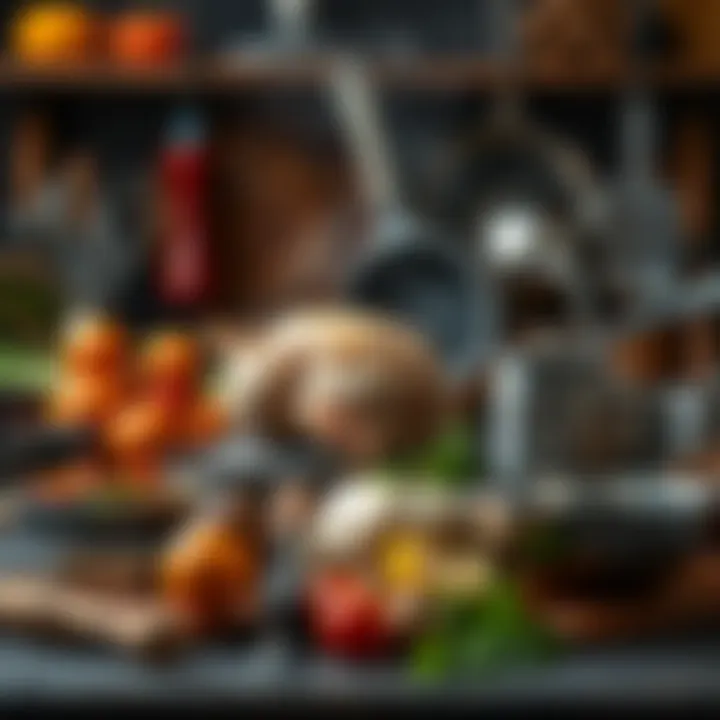
In the realm of culinary arts, the moments between the heat of cooking and the joy of serving hold significant weight. Particularly when it comes to whole chicken, the processes of resting and serving are not mere afterthoughts; they play a fundamental role in ensuring a delightful dining experience. Properly executed, these steps not only enhance the flavors and texture but also reflect the consideration put into the dish.
Importance of Resting the Chicken
Resting the chicken after cooking is akin to letting the paint dry before revealing a masterpiece. Once the bird is finished roasting or grilling, it’s essential to let it rest for about 10 to 15 minutes. This time allows the juices to redistribute throughout the meat, resulting in a moist and flavorful dish. If carved too soon, all those precious juices tend to run out, leaving you with a dry chicken that no seasoning can save.
Ultimately, this small act translates into a significant difference in flavor and texture, enabling diners to savor every juicy bite. It’s not just a tip; it’s a testament to craftsmanship in the kitchen.
Carving Techniques
When it’s finally time to carve the chicken, having the right techniques at your fingertips can elevate your plating to the next level. Two primary approaches stand out: the leg and thigh separation and breast carving. Mastering these methods ensures that each piece is not only aesthetically pleasing but also retains the maximum flavor.
Leg and Thigh Separation
Leg and thigh separation is a classic carving method, emphasizing the division of the most flavorful and juicy parts of the chicken. The simplicity of this technique lies in its efficiency. One begins by making a cut where the leg joint meets the body of the chicken and gently pulls the leg away. This allows for clear access to the thigh, and the unique feature here is the tender dark meat that many avid eaters prefer.
This method is particularly beneficial for those who appreciate a hearty portion. The dark meat tends to be juicier and richer in flavor compared to the breast, making it a favorite choice among many. However, it does require a little practice to achieve a clean cut without tearing the meat. While beginners may find it tricky at first, with a bit of patience, it quickly becomes second nature.
Breast Carving
Breast carving, on the other hand, focuses on the leaner, delicate breast meat of the chicken. This technique requires a bit of finesse. Starting at the breast’s top, make a long cut along one side of the breastbone, working your way down to the rib cage. Carefully slice parallel to the bones to avoid waste, ensuring each piece is even and visually appealing on the plate.
The longevity of breast meat flavors can sometimes be seen as less intense compared to the darker cuts, but don’t underestimate its potential when cooked properly. It serves as a versatile base for sauces, allowing for plenty of creativity in flavor combinations. Keep in mind, though, that the main challenge is to prevent overcooking, which can cause this part to dry out quickly.
"Resting and carving are not just practical steps. They are the final strokes on the canvas of your culinary creation."
In summary, taking the time to let your cooked chicken rest and employing effective carving techniques will ensure that your dish isn’t just good—it will be memorable. Well-prepared servings and attention to detail in presentation can transform a simple meal into an elegant dining experience, making every gathering special.
Storage and Leftovers
Understanding how to store leftover chicken is crucial for both food safety and flavor retention. A well-cooked whole chicken can yield a variety of meals beyond the initial serving, making its storage a vital aspect of cooking whole chicken. Proper storage techniques not only extend the shelf life of your leftovers but also allow you to enjoy the tender, flavorful chicken in numerous culinary contexts. This section uncovers practical guidelines for storing chicken, as well as creative ways to turn those leftovers into delicious meals.
Proper Storage Practices
To keep your leftover chicken safe and tasty, it’s important to follow certain guidelines. First off, let the chicken cool down to room temperature before refrigerating it. Placing hot chicken directly in the fridge can raise its internal temperature, which is a no-no for food safety.
- Store the chicken in an airtight container. This helps maintain moisture and prevents the meat from absorbing odors from other foods.
- If you plan to keep it for more than a few days, consider freezing it. Wrapped tightly in plastic wrap and then placed in a freezer bag, your chicken can last up to three months while retaining good quality.
- When ready to enjoy your leftovers, always thaw in the refrigerator or using the cold water method. This ensures even heating and maintains food safety.
Understanding these practices means less waste and more delicious meals on your table.
Creative Uses for Leftovers
Once you have your chicken stored correctly, it's time to think about how to use those leftovers creatively.
Salads and Wraps
Using leftover chicken in salads and wraps can take your lunchtime routine to the next level. The versatility of chicken means it can complement various salad ingredients, from crisp greens to hearty grains. A simple chicken Caesar salad or a Mediterranean wrap with roasted vegetables is a prime example.
- Key Characteristic: Salads and wraps are generally quick to assemble, making them perfect for busy days.
- Uniqueness: You have the freedom to mix flavors and textures, combining fresh vegetables, dressings, and grains that suit your taste.
- Advantages: They provide a healthy meal option that’s not only filling but also refreshing. Plus, you can easily customize components to meet dietary preferences or what’s available in your pantry.
Soups and Stews
Another wonderful use for leftover chicken is in soups and stews. A good chicken soup can be comforting and hearty, especially on a chilly day. Adding chicken to a broth with vegetables can create a satisfying meal in no time.
- Key Characteristic: Soups and stews allow for great versatility and are forgiving in terms of ingredients.
- Uniqueness: They often improve in flavor after sitting for a day, making the leftovers a better choice in many cases.
- Advantages: Utilizing chicken in soups and stews can stretch the meal further, allowing one bird to feed a crowd. You can sneak in vegetables you have on hand, making it a nutritious option.
Final Thoughts
As we come to the end of this exploration into the delicate process of cooking whole chicken, it's clear this topic deserves more than just a passing glance. The art of mastering chicken is not simply about following recipes; it’s about developing a relationship with the ingredients, understanding the nuances of flavor, and finding joy in the cooking journey.
The importance of the Final Thoughts section in this article is manifold. It not only encapsulates the knowledge shared but also opens the door to further gastronomic adventures. Reflecting on what has been discussed lays the groundwork for future culinary experiments, allowing food enthusiasts to flex their creative muscles in the kitchen. It emphasizes that every roast, grill, or slow-cooked dish can tell a story about technique and personalization.
When you cook a whole chicken, you’re engaging in a tradition that transcends cultures and generations. From the initial steps of selection and preparation to the careful watching of doneness, each element warrants attention. The insights gained on marinating and seasoning, in particular, can elevate your dish from a simple meal to a centerpiece worthy of praise.
Furthermore, consider this: mastering techniques for whole chicken opens the floodgates to even greater culinary possibilities. Whether you’re entertaining guests or enjoying a quiet family meal, the skills you hone now will serve you well into the future.
"Cooking is like love; it should be entered into with abandon or not at all." – Julia Child
So, what’s next? Here are some approaches to enrich your cooking journey:
- Experiment with flavors: Don't hesitate to tweak marinades or change the spice blends. Your taste buds are unique, and so should your chicken.
- Share with others: Cooking with family and friends can offer new perspectives and even improve your techniques.
- Learn from mistakes: If a roast doesn’t turn out perfectly, analyze and adjust for next time. Every error is a lesson waiting to be learned.
- Explore diverse recipes: Consider global recipes, allowing you to discover how different cultures prepare chicken. (Links to popular cuisines can be found at Britannica and Wikipedia)
In summary, cooking whole chicken is a journey, one that is enriched by an enthusiastic approach to learning. This closing section is a gentle nudge to go beyond mere recipes – dive into the art and science behind the cooking and relish every bite of the experience.















